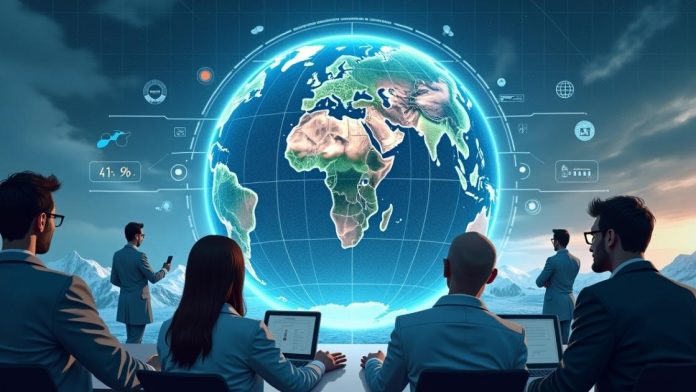Climate change is one of the most pressing challenges of our time—and it’s not just about melting ice caps or rising temperatures. It’s about understanding how a vast, interconnected system is shifting over time, reacting to everything from human behavior to volcanic eruptions. Trying to predict how it all fits together? It’s like trying to solve a puzzle with a million moving pieces.
Enter artificial intelligence (AI)—the digital brain that’s helping scientists decode the Earth’s climate with unprecedented accuracy. But this isn’t about robots taking over the world. It’s about using intelligent tools to gain deeper insights, create more reliable forecasts, and guide better decisions for our planet’s future.
If you’ve ever wondered how weather reports get more accurate, or how we plan for rising sea levels, this post will give you a front-row seat to the ways AI is transforming climate modeling—and why that matters more than ever.
What Is Climate Modeling, Anyway?
At its core, climate modeling is the process of simulating the Earth’s climate system using computer programs. These models factor in variables like:
-
Solar radiation
-
Greenhouse gas emissions
-
Ocean currents
-
Cloud cover
-
Land use changes
-
Atmospheric particles (like soot or volcanic ash)
They help us answer big questions: What will Earth’s temperature be in 2050? How will rainfall change in different regions? Which communities are most at risk of floods, droughts, or heatwaves?
But here’s the catch—traditional models are computationally intense and limited by human assumptions. That’s where AI steps up to the plate.
How AI Supercharges Climate Modeling
AI doesn’t replace scientists—it augments their capabilities. Here’s how:
1. Faster and More Accurate Predictions
AI can analyze massive climate datasets in a fraction of the time it takes traditional models. With machine learning, AI “learns” from past patterns and identifies subtle relationships that may go unnoticed by humans.
Example: Google DeepMind’s weather forecasting model can predict rainfall with higher accuracy than existing systems—within just hours.
2. Filling in Data Gaps
Satellite images and climate sensors don’t cover every square kilometer of Earth. AI helps interpolate missing data, providing better resolution in remote or data-scarce areas like the Arctic or oceanic regions.
Tip: Researchers use AI to fill in cloud gaps in satellite imagery, improving accuracy for solar radiation forecasting.
3. Improving Climate Resilience Tools
AI enhances early-warning systems for extreme weather events—giving communities more time to prepare.
Example: AI models help predict where wildfires might spread, how heatwaves will intensify, or how hurricanes will evolve.
4. Reducing Computational Load
Traditional climate simulations can take weeks or months to run. AI-powered “emulators” can mimic the output of full-scale simulations in real-time, freeing up valuable resources for scientists.
Real-World Applications of AI in Climate Science
Let’s get out of the lab and into the real world. Here are some exciting ways AI is making a difference today:
Earth Observation and Monitoring
AI processes data from satellites like NASA’s Landsat and ESA’s Sentinel to track:
-
Deforestation and reforestation
-
Melting glaciers
-
Ocean temperatures and currents
-
Methane and CO₂ emissions hotspots
Urban Planning and Climate Adaptation
AI helps city planners design climate-resilient infrastructure, from smart drainage systems to heat-resistant building materials.
Agriculture and Food Security
With predictive AI models, farmers can plan better for droughts, changing growing seasons, and pest outbreaks—helping protect food supplies.
Actionable Tips: How You Can Leverage AI and Climate Insights
You don’t need to be a data scientist to get involved. Here are a few ways to support and use AI for climate impact:
1. Explore Open Climate Data
Platforms like Climate Watch and NASA Earthdata offer free, AI-analyzed data for public use. Dive in and see how your region is affected.
2. Use Smart Climate Apps
Apps like Windy, Earth Hero, or Jupiter Intelligence use AI to offer personalized climate risk reports, carbon tracking, and sustainability tips.
3. Support AI Research for Good
Donate or advocate for initiatives that focus on AI for climate science—like Climate Change AI or Microsoft’s AI for Earth program.
4. Push for Climate-Data Transparency
Call on governments and corporations to release emissions and environmental data, allowing AI models to work more effectively for public good.
Frequently Asked Questions (FAQs)
1. Isn’t AI energy-intensive and bad for the environment?
Some forms of AI training are energy-intensive, but the net benefit of AI in climate modeling outweighs the cost. Newer methods are also becoming more energy-efficient.
2. How reliable are AI-based climate predictions?
AI improves reliability by detecting trends and anomalies. However, it works best when combined with traditional physics-based models and expert analysis.
3. Can AI help prevent climate disasters?
Yes! While it can’t prevent disasters, AI enhances early warning systems and guides smarter planning to reduce damage and loss of life.
4. Who’s leading the AI-for-climate movement?
Organizations like DeepMind, IBM, NASA, and universities around the world are pioneering this space, often in partnership with governments and NGOs.
5. Is AI replacing climate scientists?
Not at all. AI is a tool, not a replacement. Climate scientists are essential for designing models, validating data, and interpreting results.
Conclusion
The climate crisis is daunting—but the tools we now have at our fingertips are more powerful than ever. AI is not a silver bullet, but it’s a game-changing ally. By combining data, technology, and human determination, we can better understand what’s coming—and build a world that can not only survive, but thrive.
Whether you’re a tech enthusiast, an eco-warrior, or just someone who cares about the future, now is the time to stay curious, stay informed, and get involved.
We’d love to hear from you: How do you manage your time while staying committed to sustainability or learning new technologies like AI?
Drop your strategies in the comments—let’s inspire each other to make the most of every moment

